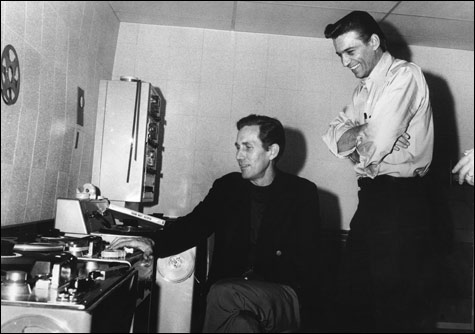
SONIC SWEETS: Studio B was built to accommodate RCA and the label’s hot country producer, Chet Atkins. |
RCA Studio B has long been known as the “House of 1000 Hits.” Here’s an A-list of some of the classics that were cut at the studio.  • EDDY ARNOLD “What’s He Doing in My World?” | “Tennessee Stud” | “A Little Heartache”
• BOBBY BARE “Detroit City”
• SKEETER DAVIS “The End of the World”
• THE EVERLY BROTHERS “Let It Be Me” | “Cathy’s Clown” | “When Will I Be Loved”
• DONNA FARGO “The Happiest Girl in the Whole U.S.A.”
• DON GIBSON “Oh, Lonesome Me” | “I Can’t Stop Loving You” | “Sea of Heartbreak”
• WAYLON JENNINGS “The Only Daddy That’ll Walk the Line”
• GRANDPA JONES “T for Texas”
• HANK LOCKLIN “Please Help Me, I’m Falling”
• ROY ORBISON “Only the Lonely (Know How I Feel)” | “Crying” | “Running Scared” | “Dream Baby (How Long Must I Dream)”
• DOLLY PARTON “Coat of Many Colors”
• ELVIS PRESLEY “Are You Lonesome Tonight?” | “Stuck on You” | “It’s Now or Never” | “Little Sister” | “Good Luck Charm”
• JIM REEVES “He’ll Have To Go” | “Welcome to My World”
• HANK SNOW “I’ve Been Everywhere” | “The Last Ride”
• GARY STEWART “She’s Actin’ Single (I’m Drinkin’ Doubles)”
• PORTER WAGONER “Misery Loves Company” | “The Carroll Country Accident” | “I’ve Enjoyed This As Much As I Can Stand” | “The Last Thing on My Mind” [with Dolly Parton] Other musical meccas. By Ted Drozdowski |
NASHVILLE — Before the digital universe expanded, serious home recording was just a dream, or something musicologists like Alan Lomax did on machines the size of VW beetles in the shacks and fields of rural backwaters. Well into the ‘90s, music meant for radio, jukeboxes, and stereos had to be made in professional studios. And most big-time albums still are. But not all studios are equal. Some were — as William Clark and Jim Cogan call them in the title of their 2003 book on great recording rooms — Temples of Sound (Chronicle). And one of the holiest, at least to diehard fans of American roots music, has always been Nashville’s RCA Studio B.This year, Studio B, right off famed Music Row, where the heart of today’s commercial country industry beats hardest, is celebrating its 50th anniversary. The 1611 Roy Acuff Place building is a plain two-story affair. The only exterior mark of its history is the chink in the brickwork where Dolly Parton thumped the wall with her first car on the way to one of her early recording sessions. And Studio B is a rarity among the most famed sonic citadels because it remains intact and its doors are open to civilians. The Country Music Hall of Fame and Museum has conducted tours of the “House of 1000 Hits” since 1977, and today it leases the room from the Curb Family Foundation — which maintains the space — for $1 a year.
It’s more professional-looking than tiny Sun Studio, the sonic temple where rock was born. But Sam Phillips opened Sun in Memphis seven years before Studio B was built by Nashville businessman Dave Maddox to accommodate RCA’s local recording interests and the label’s hot country producer, Chet Atkins. Whereas Sun looks like a glorified one-car garage, Studio B has the beveled walls and high ceilings that engineers had discovered help eliminate sonic pitfalls.
Not that there weren’t plenty in the big shoebox-shaped structure. “It’s not that remarkable a space,” says John Rumble, senior historian for the Hall of Fame and Museum. “It’s a concrete block building, so you have to give a lot of credit to the engineers. As Bill Porter, who was chief engineer from 1959 to 1963, explained to me, the building had a lot of standing waves on certain frequencies. If a wave comes out of a sound source, like an amplifier, bounces off a wall, and travels back, it has cancellation points, where the sound will drop out, and amplification points, where the volume will increase. Porter got acoustical ceiling tile, cut it into little pyramids, and hung them at different levels to break up the ceiling waves. They were called ‘Porter’s Pyramids’ by the session musicians who worked there.”
Rumble hasn’t been able to determine who the first artist to record at the studio was when it opened in November 1957. Ralph Stanley — the octogenarian bluegrass legend whose career got a supercharging in 2000 when he sang the riveting “O Death” in the soundtrack for O Brother, Where Art Thou? — and the late Canadian singing cowboy Hank Snow were among the earliest. Then came Elvis Presley, who’d recorded “Heartbreak Hotel” in a downtown broadcasting building RCA used before Studio B opened. He cut “Are You Lonesome Tonight,” “It’s Now or Never,” “Little Sister,” “Good Luck Charm,” and many other hits at Studio B. Roy Orbison and the Everly Brothers made smashes there. And many Nashville stars ascended both the pop and the country charts with songs from Studio B, often under Atkins’s production. Eddy Arnold’s “What’s He Doing in My World?”, Bobby Bare’s “Detroit City,” Waylon Jennings’s “Only Daddy That’ll Walk the Line,” and Dolly Parton’s “Coat of Many Colors” are all part of the legacy.